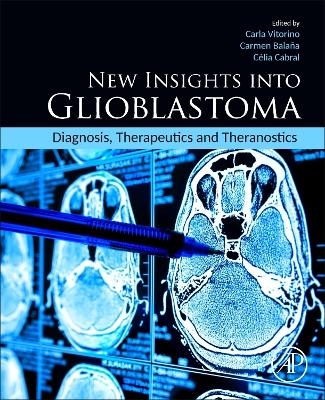
New Insights into Glioblastoma
Academic Press Inc (Verlag)
978-0-323-99873-4 (ISBN)
The book is split in three parts: Diagnosis, focusing on biomarkers and techniques such PET/MRI, infrared thermography, and deep neural networks; Therapeutics, discussing new chemical entities, as natural products and repurposed drugs, and new formulation approaches, as nanotechnology-based and microRNA approaches; and Theranostics, explaining the role of omics, system-based approaches, and glioblastoma microenvironment.
Carla Vitorino is Assistant Professor at the Faculty of Pharmacy, University of Coimbra. in the Pharmaceutical Technology area and is an integrated researcher at the Coimbra Chemistry Centre, currently a part of the associate laboratory Institute of Molecular Sciences (IMS). Her research and development activities have been fundamentally directed towards three interrelated focal points: (i) Scientific: The primary emphasis here pertains to the formulation of more effective strategies in conjunction with drug nanodelivery systems, tailored to address multipurpose requisites within unmet medical needs. Specifically, she has been working on the application of nanotechnology in drug permeation enhancement strategies for transdermal, oral, and drug delivery systems to brain targeting. Under the projects she has coordinated and co-coordinated, she has contributed to the development of advanced nanotechnological formulations, specifically tailored for brain targeting in the context of tumor treatment and diagnosis. Through the integration of in silico-in vitro-in vivo approaches, she has fostered the development of new treatment strategies for brain tumor patients and improved diagnosis, establishing the bridge between pharmaceutical research and clinical practice. Alternative routes to access brain (e.g. intranasal administration) for delivering drugs in a more efficient way have also been explored. (ii) Industrial: This has been grounded on the systematic deployment of frameworks driven by a quality by design (QbD) philosophy, along with process analytical technology (PAT) tools. The central tenet lies in the application of structured approaches to the development of specific drug products, including but not limited to semi-solids and injectables. Concomitantly, in-line process control and monitoring mechanisms are incorporated. (iii) Regulatory: This has been directed to the development of analytical protocols, elaborated as surrogate modalities for clinical trials. These protocols, addressing in vitro methodologies, are designed to facilitate the bioequivalence assessment of generic topical drug products, thus holding relevance in regulatory contexts. Carmen Balana created one of the first neuro-oncology committees in Spain and was a founder of the Spanish Neurooncological Group (now GEINO), where she was president and remain an active member. Her first publication as first author in a high-impact journal was in 2003 on liquid biopsies in high-grade gliomas, which has only recently become a strong research line. Other professional accomplishments: EORTC Brain Tumor Study Group (since 2002); reviewer and Editorial Committee member on several journals, including Neuro-Oncology; invited speaker at ESMO 2019 and ESMO ASIA 2020; President, IGTP Internal Scientific Committee (since 2017); President, Catalan-Balearic Oncology Society (since September 2020); PI, 70+ clinical trials (35 in CNS). She coordinated several ISCII grants and recently the Marató TV3 (665/C/2013) grant (1,690,500€), when she was able to coordinate six Catalan hospitals on a large clinical, radiological, immunohistochemical and molecular study of glioblastoma. Célia Cabral graduated in Biology from the University of Coimbra and obtained her PhD in Biology, in the speciality of Systematics and Morphology, by the same institution, involving the Faculty of Sciences and Technology, the Faculty of Pharmacy and the Royal Botanic Garden Edinburgh (RBGE), UK. Between 2011 and 2017, Dr. Cabral did a 6-year post-doc at the Faculty of Pharmacy of UC. Currently, she is Researcher at the Faculty of Medicine of the University of Coimbra and Invited professor at the Universidade Lusófona. She has a multidisciplinary scientific path, with emphasis in Phytochemistry, Pharmacognosy, Natural products and Plant-based health solutions. Her main research interests are ethnopharmacology, phytochemistry, drug delivery of natural products, development of food supplements and natural products-based cosmetics.
I. Introduction1 Introduction: A brief outlook into glioblastoma diagnosis and therapeutics
II. DiagnosisII.1 Biomarkers2. Practice guidelines for the diagnosis of glioblastoma3. Identification of potential biomarkers in glioblastoma through OMICS technologies and Big Data Analysis4. Forging a path to the use of liquid biopsy in the diagnosis of gliomas 5. Secretome analysis of patient-derived glioblastoma cells for potential biomarker identificationII.2 Techniques: updates6. Newly diagnosed glioblastoma: a review on clinical management7. Current status in brain glioma imaging (MRI, CT-Scan)8. Combined PET/MRI in brain glioma imaging9. New surgical approaches in glioblastoma10. The role of radiogenomics
III. TherapeuticsIII.1 New chemical entities11. An overview of molecular targeting of glioblastoma12. Terpenes: a hope for glioblastoma patients13. The artificial intelligence contribution to speed-up the active compounds screening14. Repurposing drugs in glioblastoma15. Glioblastoma heterogeneity and resistance: a glance in biology and therapeutic approach16. Targeting DNA damage response pathways in glioblastoma: from mechanistic insights to advances in the clinic17. Alkaloids: their relevance in cancer treatmentIII.2 New formulation approaches18. An overview of current drug delivery strategies for glioblastoma treatments and barriers to progress19. Nanotechnology-based approaches in glioblastoma treatment: how can the dual blood brain/tumor barriers be overcome?20. Non-coding RNAs in glioblastoma at a glance21. The role of vaccines in glioblastoma – updated clinical results22. Dendritic cells and glioblastoma23. Cancer stem cells in glioblastoma – an update24. Optimizing the role of immunotherapy for treatment of glioblastoma25. The role of exosomes in glioblastoma treatment
IV. Theranostics26. Theranostic in glioblastoma27. Potential theranostic targets in glioblastoma 28. Radiopharmaceuticals for molecular imaging and theranostics of glioblastoma29. Theranostic strategies synergistically potentiate glioblastoma treatment via nanotechnology30. The effect of glioblastoma microenvironment on theranostics
| Erscheinungsdatum | 10.07.2023 |
|---|---|
| Zusatzinfo | 130 illustrations (80 in full color); Illustrations |
| Verlagsort | Oxford |
| Sprache | englisch |
| Maße | 191 x 235 mm |
| Gewicht | 450 g |
| Themenwelt | Medizin / Pharmazie ► Medizinische Fachgebiete ► Onkologie |
| Naturwissenschaften ► Biologie | |
| ISBN-10 | 0-323-99873-9 / 0323998739 |
| ISBN-13 | 978-0-323-99873-4 / 9780323998734 |
| Zustand | Neuware |
| Haben Sie eine Frage zum Produkt? |
aus dem Bereich


